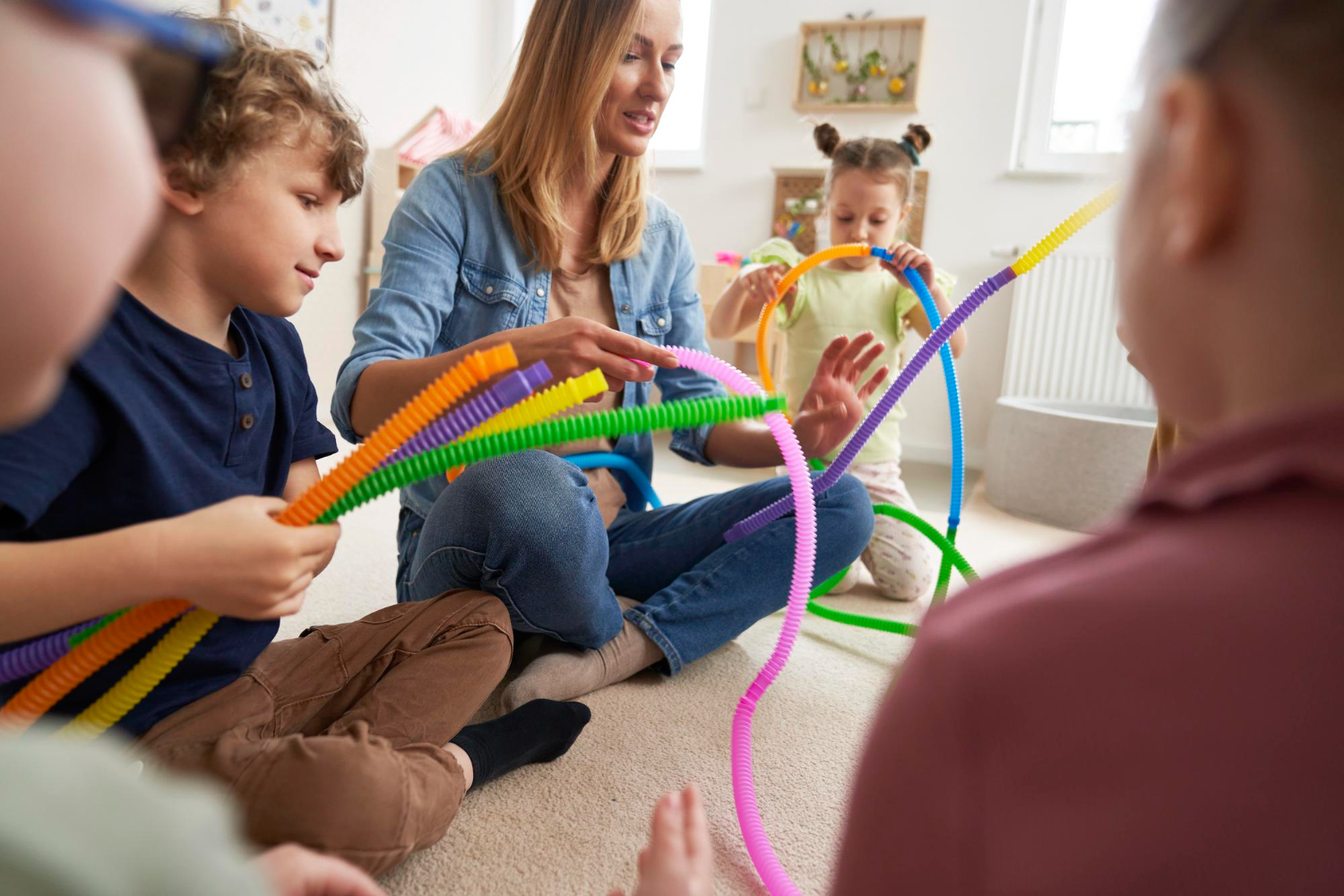At Theracare Pediatric Services, we understand how important it is to support your child’s growth and independence. That’s why we offer a range of pediatric services—including occupational therapy, speech therapy, physical therapy, and learning support—designed to meet the unique needs of every child.
Occupational therapy (OT) isn’t just for adults recovering from injuries or illnesses—it’s also a powerful tool for children. Pediatric occupational therapy can help kids overcome developmental delays, sensory processing issues, and physical challenges. OT can make a big difference in a child’s daily life by improving essential life skills like coordination, fine motor skills, and sensory integration. If your child is facing challenges, occupational therapy could help them thrive.
Occupational therapy for kids focuses on therapeutic activities that help children build essential skills, increase confidence, and develop the tools they need to succeed in school and everyday life. Occupational therapy can make a big difference in children’s development by improving fine motor skills, sensory processing, and social abilities. Please keep reading to discover how occupational therapy can support your child’s growth and set them up for success!
What Is Pediatric Occupational Therapy?

Occupational therapy for kids, also known as pediatric occupational therapy, helps children build essential skills for daily life and independence. This therapy focuses on improving fine motor skills, gross motor skills, and sensory processing, which are crucial for a child’s development. The goal of pediatric occupational therapy is to support children in reaching their full potential by helping them succeed in school, develop social skills, and participate in activities they love, like sports, arts and crafts, or group play. Occupational therapy could be the perfect solution if you’re looking for ways to enhance your child’s development and build their confidence.
Children of all ages can benefit from occupational therapy, especially those with:
- Sensory processing disorders
- Autism spectrum disorder
- Injuries that might affect motor skills
- Developmental delays or learning disabilities
- Trauma or anxiety
- Difficulty with fine motor skills or gross motor skills
Occupational therapy for children is a powerful way to support kids who may be struggling in school, facing challenges with social skills, or dealing with developmental delays. By focusing on practical strategies, occupational therapy helps children build essential life skills, overcome obstacles, and develop greater independence. Over time, this support can boost their confidence, helping them academically and socially thrive. If you’re looking for ways to help your child succeed, occupational therapy might be the solution you need.
Signs Your Child Might Benefit From OT

A pediatrician or healthcare provider can guide you in deciding if occupational therapy is the right option for your child. Typically, occupational therapy can be beneficial for children who demonstrate:
- Challenges with fine motor skills, such as manipulating scissors or gripping a pencil.
- Challenges with gross motor skills, such as difficulties with running or jumping
- Heightened or reduced sensitivity to specific textures or sounds
- Challenges in mastering self-care skills
- Difficulty with social interactions
These general guidelines highlight how occupational therapy (OT) can support children in various areas of development. Occupational therapy provides kids practical tools and strategies to overcome challenges, improve their skills, and build confidence in everyday activities.
Occupational Therapy and Autism
Occupational therapy is an essential resource for helping children with autism achieve developmental milestones and unlock their full potential. Through personalized strategies, occupational therapy supports children on the autism spectrum by addressing challenges in key areas such as:
- Sensory Processing Challenges in Autism: Occupational therapists use tailored activities to help autistic children manage sensory processing difficulties. These personalized plans are designed to reduce sensory overload and improve their ability to navigate everyday environments.
- Daily Living Skills Support: Occupational therapy helps individuals develop or improve essential daily living skills, including dressing, eating, and personal hygiene, to foster greater independence and quality of life.
- Motor Skills Development for Kids: Occupational therapy (OT) exercises are designed to help children improve essential motor skills, including coordination, balance, and fine motor abilities. These targeted activities support tasks like writing, using utensils, and overall motor planning, ensuring kids build the skills they need for everyday activities.
- Social Skills Development: Occupational therapy (OT) helps children improve social skills through structured activities and play. This includes building non-verbal communication skills, learning to take turns, recognizing and understanding emotions, and practicing how to engage in play with peers. These essential social skills are key to successful interactions with other children and adults.
- Behavioral Regulation Strategies for Kids: Occupational therapy offers practical techniques to help children manage emotions, reduce anxiety, and improve concentration. These strategies can enhance focus and support emotional well-being, making them ideal for kids struggling with self-regulation.
- Adaptive tools and techniques for children: Occupational therapists help kids succeed by introducing adaptive equipment and strategies, such as visual schedules, sensory tools, and specialized learning aids. These tools make daily tasks and learning more accessible for children with unique needs.
Occupational therapy provides essential support by improving key skills like communication, sensory processing, and motor development. This therapy helps autistic children build independence, participate in everyday activities, and enjoy the things they love. Learn how occupational therapy can make a lasting difference for children on the autism spectrum.
The Role of an Occupational Therapist

Occupational therapists are crucial in helping children develop important skills and reach their full potential. Through personalized pediatric therapy plans, they address each child’s unique needs using effective techniques like play therapy, sensory integration, and motor skill development. These child development specialists also work closely with parents and caregivers, providing practical strategies to support progress at home. Occupational therapists often collaborate with other professionals, such as physical and speech therapists, to deliver comprehensive, child-focused care. This team-based approach can deliver lasting results if you’re looking for expert pediatric occupational therapy to improve your child’s motor skills, sensory processing, or daily living abilities.
During occupational therapy sessions, children may work with occupational therapy assistants (OTAs) who play a key role in their development. OTAs support kids by guiding them through therapeutic exercises, offering clear instructions, and tracking their progress. This hands-on approach helps improve motor skills, build independence, and achieve therapy goals, making occupational therapy more effective for children.
What to Expect During an OT Session
Occupational therapy sessions for adults and children share similar goals but differ slightly in approach. For adults, an occupational therapy session typically includes exercises, stretches, and activities to improve movement and personalized recommendations from a licensed occupational therapist. For children, occupational therapy focuses on skill development through fun and engaging activities, often using toys or games designed to enhance motor skills, coordination, and overall development. Whether you’re exploring occupational therapy for kids or adults, these sessions are tailored to help individuals achieve greater independence and improve their quality of life.
The frequency and duration of occupational therapy (OT) sessions depend on your child’s needs and goals. Typically, OT sessions can range from 30 minutes once a week to 60 minutes multiple times a week, depending on the level of support your child requires. An experienced occupational therapist will design a customized therapy plan tailored to help your child achieve important developmental milestones.
How often should your child go to occupational therapy or what happens during a session? Speak with a licensed occupational therapist to get expert advice on the best therapy schedule for your child. Occupational therapy is a proven way to support children with developmental delays, sensory processing challenges, or fine motor skill difficulties. By creating a consistent OT routine, your child can build the skills they need to thrive in everyday life.
How to Get Started With Occupational Therapy

The first step in accessing occupational therapy for your child is to speak with their pediatrician or healthcare provider. They can help assess your child’s needs and determine if occupational therapy is the right choice. By consulting a professional, you can take a crucial step toward improving your child’s development, motor skills, and overall well-being.
Occupational therapists play a key role in improving the lives of people of all ages by helping them build essential skills for daily living. Whether you’re searching for pediatric occupational therapy for your child or adult occupational therapy services, finding the right provider near you is crucial. Many occupational therapists work in occupational therapy clinics, schools, or offer home healthcare services. According to the U.S. Bureau of Labor Statistics, these professionals help individuals overcome physical, developmental, or emotional challenges. You can often access occupational therapy services through local schools, private practices, or clinics near you. Discover how occupational therapy can make a positive impact on your life today!
Be sure to check with your health insurance provider to see if occupational therapy is covered by your plan. Understanding your insurance coverage for occupational therapy can help you plan for treatment costs and avoid unexpected expenses.
Support Your Child’s Growth with Theracare Pediatric Services
Every child deserves to reach their full potential. Our compassionate and experienced team is here to guide your family every step of the way. Contact Theracare Pediatric Services today to learn more about our occupational therapy programs or to schedule an evaluation.
Frequently Asked Questions (FAQs)
1. What does a pediatric occupational therapist do?
A pediatric occupational therapist helps children develop skills needed for everyday activities like writing, dressing, eating, and playing. They use customized exercises and play-based therapy to improve motor coordination, sensory processing, and independence.
2. How do I know if my child needs occupational therapy?
If your child struggles with fine motor tasks, shows delays in physical development, avoids certain textures or sounds, or has difficulty with daily routines, a pediatric occupational therapy evaluation can help determine the best course of action.
3. What age should a child start occupational therapy?
Children can begin occupational therapy as early as infancy if developmental delays are detected. Most kids begin OT between ages 2 and 6 when delays in speech, coordination, or sensory integration are commonly identified.
4. How long does a child need occupational therapy?
The duration of therapy varies depending on the child’s individual needs and progress. Some children may need therapy for a few months, while others may benefit from long-term support to reach their developmental goals.
5. Can my child get occupational therapy through school?
Yes, many children receive occupational therapy through school if it’s part of an Individualized Education Program (IEP) or 504 Plan. If your child doesn’t qualify through school, private therapy clinics like Theracare can provide services.
6. What are some activities used in pediatric occupational therapy?
Therapists may use games, arts and crafts, obstacle courses, or sensory bins to engage children while building essential motor and cognitive skills in a fun, supportive environment.
7. Does insurance cover occupational therapy for kids?
Many insurance plans cover pediatric occupational therapy, but coverage varies. Check with your provider Support Your Child’s Growth with Theracare Pediatric Servicesr contact Theracare Pediatric Services to verify your benefits and discuss options.





